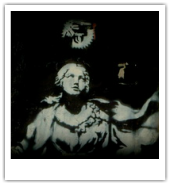 AS a lifelong fan of Keith Haring, I love stumbling across his ongoing influence, even now that he is long gone from this place. In the past I blogged about the mural in Melbourne that Keith produced in the early eighties and the attempts at conserving it for future generations. Keith made it to rarefied territory for a contemporary artist. His unique view at the world and the way in which he made it accessible to people made him one of the most loved figures of modern popular culture. It didn't hurt that he came up during New York's eighties renaissance. But there's something about Keith's work which has always resonated across the generations and the cultures. And the Keith Haring Foundation continues to spread his message through its partnering with all kinds of initiatives around the world. There have been events in Latin America, Europe, Australia among others that have kept his legacy alive for new generations. That makes me, as a fan of his, happy. So, I was really quite chuffed to see that the local chapter of the Arcigay association, Arcigay Salento, has partnered with the Keith Haring foundation for their second annual Viva La Vida contest. The idea behind the contest is two fold: it is designed to highlight contemporary art and issues which affect the LGBT(QI...) community. This year's theme is tied to Keith: artworks inspired (not necessarily mimicking his style) that highlight the main elements of the project. Selected works will then be voted for via the group's Facebook page and possibly be selected for inclusion at the exhibition which will be staged at the contest's end. I imagine the emphasis is on local artists, but I love the idea of this kind of project. It's inspiring and heartwarming. I'm happy that there will be a little piece of Keith for me to enjoy in the new year, and my little black heart is unexpectedly warmed by the whole thing. Who knew.
0 Comments
 A long, long time ago, I posted about moves to protect the public mural in Melbourne by Keith Haring. That was back in 2010. Today, I happened to be doing some flicking around the net, and I came across this update in a Melbourne GLBT mag as well as a friend of mine in the society pages (again. He is always in there!). It seems at least that Arts Victoria and Heritage Victoria are onboard and that surrounding redevelopment of the site is being done in a way in which the dignity of Keith's artwork is at least being maintained. Apparently there's a plan in the works people to help protect a bit of old skool street art. Back in 2003, Banksy made his way to Melbourne, arguably around the time that the stencil scene there was beginning to organically peak before it developed into a mini cottage industry. Banksy's trip to Melbourne occured at a time when Melbournians still viewed stencil art as a pesky disadvantage of their climate and of city life, long before its value was appreciated by a wider audience. Banksy has since been recognised as a bit of a genius, and where years ago people used to get up in arms about stencil art in public spaces, today people are getting up in arms because not enough is being done to protect the more infamous and better executed works. If you trawl the internets then undoubtedly you would have come across the mini media storm that a plumber generated by drilling into one of Banksy's rats. Does it count as a case of veternary science? Melbourne has made the mistake before both intentionally and unintentionally. Part of the problem is that we still equate value with the economics of street art. Street art is not as Melbourne City Council and the like believe, about maintaining an outdoor museum to perpetuate the big names of the scene and to capitalize on tourism; thats a happy byproduct; its about encouraging and protecting a different form of social engagement. which is often witty and visually stimulating. As with everything in the public domain, there are issues to overcome, including issues about property rights, but, its not rocket science. The latest incident is a case that could have been easily avoided, and instead it turned into an embarrassment for all involved, and a great loss to the community, because those rats enrinched their environment. They weren't merely scavengers. Before taking on an international persona of their own, the works of Keith Haring were once indelibly linked with the evolving graf inspired street culture of early eighties NYC.
Often bright, sparse and almost childlike in their urgency, there was something about their appeal which seemed to transcend the limitations of their basic line structures. Eventually, they would go on to enjoy mass universal appeal, on the basis of the accessible way in which the images seemed to reduce the major stages of life down into decodable and distinctly Haring shapes, such as the Radiant baby. Haring's characters were affectionate and powerful drawings that appealed to the eye whilst also addressing major life themes of love and sex, birth and death, and to a lesser extent, social warfare. Haring, to my mind, was one of the first public faces of the AIDS epidemic that seemed to otherwise haunt the atmosphere of popular culture in the eighties and nineties. Diagnosed in 1988, he never shied away from the opportunity to raise awareness and to educate the fear out of the younger generations, despite being in the front line of one of modern life's most horrific syndromes. He founded the Keith Haring Foundation only in 1989, but by the time of his untimely death in 1990 from complications arising from AIDS, his imagery was already becoming synonymous with AIDS and HIV related charities due to the work of his foundation. His artwork also graced record covers, including the 1987 compilation 'A Very Special Christmas' which benefitted the Special Olympics, on which we saw the Madonna and child in trademark Haring style. His imagery was also licensed to the Red Hot organisation, who used Haring's images on their 'Red Hot and Dance' compilation of 1992, featuring George Michael and Madonna. His journey towards fame and success seemed to coincide with that of Madonna's, a friend for whom he sometimes produced work, and who in turn dedicated a fund raising show to him during the NYC leg of her Blond Ambition tour in 1990, subsequently documented in her Truth Or Dare/In Bed With Madonna movie of 1991. Starting out as a tagger, even from the earliest periods of his career he never let mediums constrain him, working on small and large scales and in both 2D and 3D media. The fun, irreverency and urgency of Haring's images seemed to change significance over time, more and more coming to represent modern day images of compassion, especially after the passing of his life. Even before his death he was considered a significant contemporary artist, and to some of us, was as important to contemporary art as Warhol had been to the pop art movement. His significance led to him being commissioned to produce public art pieces in various parts of the world as Italy and Australia. In Australia, a visit in the mid 1980s resulted in a mural being produced for the now former Collingwood Technical College building in Melbourne, an image of which is located here: (http://images.smh.com.au/2010/01/14/1038843/wbTOTEwall-600x400.jpg). Unfortunately, the momentum which led to Haring's production of the mural with the aid of Collingwood Tech students was lost soon after, and the mural has been left to deteriorate since being produced in 1984. Now, a growing movement (for which a Facebook page has been created: (http://www.facebook.com/group.php?gid=117064188315110&v=wall&ref=ss#!/group.php?gid=117064188315110&v=info&ref=ss) is seeking to redress this, raising questions along the way as to the best way in which to conserve the mural for future generations, in addition to seeking public and financial support to facilitate any conservation work. The mural in its current state is in such a state that it needs restoration, an idea which some supporters find disturbing. To my mind, leaving and merely preserving the mural in its currently faded state is disrespectful to the legacy of Keith Haring, and also speaks of a problem that many countries have in maintaining their public art. In Australia it seems, little is done in the way of preserving public art works for future generations. That the Keith Haring Foundation is on hand to offer guidance in addition to the technical skill set available in Melbourne seems like a no-brainer to me, however it doesn't seem that straightforward in Melbourne at the moment (http://www.abc.net.au/local/photos/2010/04/28/2884980.htm), where support is still being garnered and media coverage of the issue still sparse. Its amazing to consider that an artwork produced for the public by an artist of Haring's calibre, in a country as unpopulated as Australia would have been left to deteriorate in the way it has been, particularly with its location in the nexus of Melbourne's artworld. Even more distubring still, is the debate as to how and if to proceed in its restoration. But, in many ways, Melbourne has a hit and miss, and occasionally, disgraceful track record with public art, which is surprising given how much cultural capital contributes to the city's identity (not to say its economy). There have been too many instances recorded where public pieces have been collected and left to deteriorate in council storage yards, occassionally re-sold to other municipalities, but mostly left to weather outdoors. Perhaps, my being in central Italy these days, with its abundance of public buildings, artworks and areas, most of which have been well restored and maintained, has made me cynical towards the reasons behind the travesty of this situation that has befallen Haring's Melbourne mural. In recent days, I've seen the Sistine Chapel (restored in the face of great controversy in the 1990s), the now-UNESCO listed medieval city of Siena, the Colosseum (which potentially will be partially obscured by scaffolding this year in its upteenth clean up) and lesser known structures and artworks such as that in the attached image, located in Rome, near my work, which is currently undergoing repair and restoration. The reason I name check all of these places is not to brag at how fortunate I am to be in proximity to these things, and in the position to visit them at my leisure, but instead to point out that even if the original paint pigments are no longer always visible; even if the original structural material is now augmented by modern day techniques and matters, the spirit of the originals is still most definitely present, and leaves the viewer not with a wistful sadness as to not having been able to truly witness the original, but instead a feeling of wonderment that in the most powerful pieces of art, the divine and the physical are right there for our taking. In turn, this continues the cycle of an artwork or monument which, was theoretically, once wanted because it had been commissioned, and is still loved because it has been diligently cared for. Keeping art alive is the responsibility of everyone, and in the case of Haring's mural, his trademark vibrancy, and lively approach to line need to be resurrected for the longterm, not merely mismanaged until there is no point of return. |
Dave
|
|
|
Dave Di Vito is a writer, teacher and former curator.He's also the author of the Vinyl Tiger series and Replace The Sky.
For information about upcoming writing projects subscribe to the mailing list. Dave hates SPAM so he won't trouble you with any of his own. He promises. |





 RSS Feed
RSS Feed